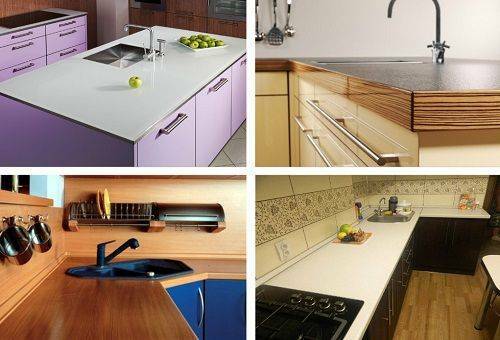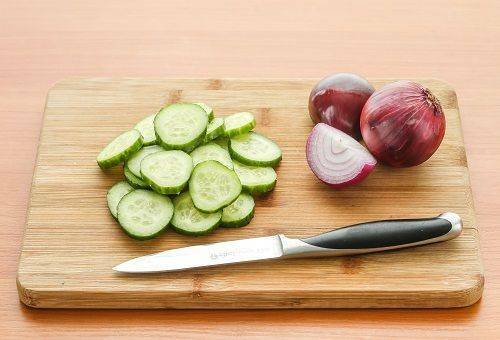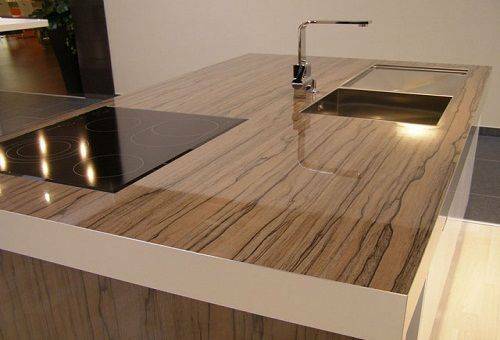Contents:
- Basic rules for work on the worktop and regular surface care
- Methods for protecting the countertop from the formation of stubborn spots
- Hardening and sealing the tree - manipulations that increase the practicality of the material
In modern kitchens, you can find countertops made of artificial or natural stone, glass, stainlesssteel, ceramic tiles, but most often as the main material is used a wooden massif or sheets of particleboard, lined with plastic. If you do not know how to protect a capricious surface, there is a risk of deformation and rapid destruction under the influence of moisture and other negative factors.

Compliance with the basic rules for the care of raw materials will avoid unpleasant consequences. In addition, there are many effective approaches that contribute to improving the quality of the product and its resistance to external influences.
Basic rules for working on the worktop and regular surface care
To prevent scratches and other types of damage on the surface of the countertop, the following rules for the work must be observed:
- When cooking, you need to use cutting boards, even if you do not need to cut anything. When cutting food, you need to ensure that the process does not go beyond the special stand.
- It is not necessary to leave knives and forks on the surface of the table top, it is because of them that the sheets of chipboard are quickly covered with a layer of scratches. In small holes, drops of water and food particles are gradually clogged, which causes swelling and warping of the wood.
- If a hand grinder or similar unit is to be attached to the work surface, a soft cloth pad must be used.
- Regardless of the material from which the surface of the countertop is made, it must be protected from prolonged and profuse exposure to moisture, during cleaning it is highly not recommended to use abrasives, metal sponges and brushes.
Tip: If the surface is additionally coated with varnish or paint, then the use of chemical cleaners, especially solvents, will also have to be discarded.
- In extreme cases, the working area can be protected with a special oilcloth. The main thing is to choose a material that does not change the flavor and taste of processed products.
- It is not recommended to put hot dishes on wood, chipboard sheets and tiles, we must always use a protective lining( make sure that it is not made of metal or plastic, but wood or multi-layer fabric).

Even if all these rules are observed, the safety of the coating is not guaranteed. It is possible to protect the wooden surface reliably only by properly cleaning it and special pretreatment.
Methods of protecting the countertop from the formation of stubborn spots
No matter how carefully the work on the specialized site was performed, stains can not be avoided, especially if it is located near the sink. Drops of water and detergent can deliver no less problems than traces of fat. To ensure that the surface of the countertop does not darken and does not become covered with signs of decomposition of the material, the following tips should be adopted:

- Dry dirt, grease and traces of moisture should be removed immediately. Do not wait until the various components are mixed and dried, turning into a dense crust.
- For regular cleaning of the solid wood or chipboard sheets, a mild and slightly warm soap solution is allowed.
- Persistent stains can be removed with lemon juice. If, at the same time, some salt is poured onto the surface of the contamination, it will be possible to draw dirt out of small scratches.
- A darkened tree is recommended to be treated with a weak solution of hydrogen peroxide. Just pour it on the stain and after a few minutes wipe it off with a soft cloth. This same manipulation allows you to decontaminate the surface.
- In some cases, professional bleaches for wood or homemade preparations based on oxalic acid are used. They simultaneously draw mud from the cracks, preventing the expansion of the tree, bleach and disinfect the material.
Fresh top table top is best treated without using water. You can simply rub the dirt with medium-grained sandpaper to remove the stain, then sand the surface with the softest product analog.

Hardening and sealing of wood - manipulations that increase the practicality of
material To minimize the damage from moisture and other external stimuli, a massive tree can be hardened. True, this manipulation is very different from the approach used in the case of metal:
- Pour a little warmed mineral( not food!) Oil on the working area. We wait for a few minutes while the fibers absorb the desired amount of the product.
- Take a rag and begin to rub the composition into the surface, acting in the direction of the location of the fibers.
- We leave the construction for half an hour, so that the main component is well absorbed. We make sure that at this time there are no drops of water on the table top, hence the effectiveness of the approach will decrease.
- Wipe the treated area with a waffle or paper towel, removing excess oil.

If the main material is the sheets of particleboard, the optimal protection against damage will be the sealing procedure. To use it, we use ready-made polyurethane( for the food industry), which is applied to the problem area in at least three layers. After such a simple manipulation of problems with cleaning the countertops will not arise, and to the effect of moisture it will become indifferent. You can not cut products on this surface anyway!
Wood wax for furniture can be used to restore the wood and eliminate cracks. For this, we warm it up on a stove or in a microwave oven. For one part of the product we take four parts of the mineral oil, mix it. Even with a warm compound, we process the problem areas, carefully rubbing the preparation into cracks. Leave the mass to dry, then polish the surface with a soft cloth. Such manipulation is recommended to be carried out at least once a year for the purpose of prevention.



